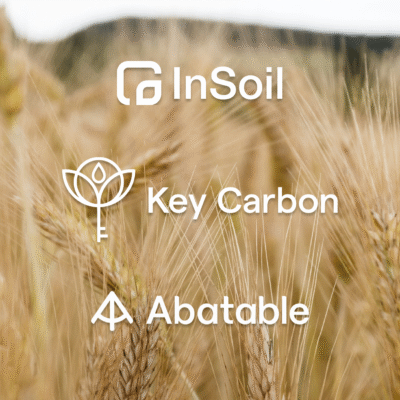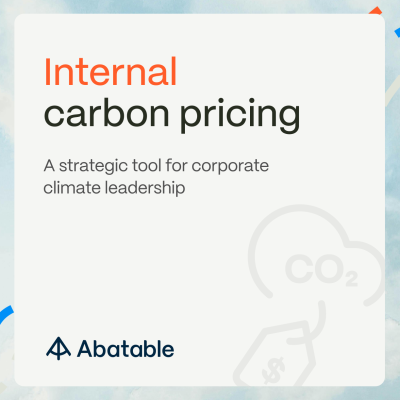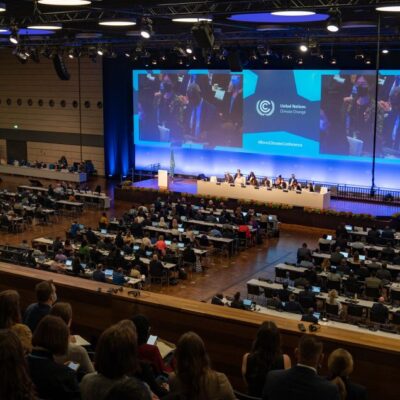As Abatable’s Policy Analyst Valentina Hernandez Gomez and Policy Manager Greg Lydka Morris explain, carbon markets were one area where successful progress was made at COP29 – but there are still many elements to iron out before Article 6 becomes operational. This is an edited version of an article from our weekly carbon market updates. Sign up here to get these insights in your inbox.
COP29 in Baku concluded on Sunday 24 November – a couple of days behind schedule, as is the norm – with outcomes for two of the Azerbaijan COP presidency’s key aims for the conference: agreements on Article 6 and climate finance.
For the former, the conference delivered early progress towards operationalising Article 6.4, and finished with last-minute agreements on guidance for both Article 6.2 and Article 6.4. However, for the latter, the final agreement on post-2025 climate finance fell short of expectations.
Here we summarise the main outcomes for both areas and explain what they mean for the market.
Article 6 developments
Article 6 progressed on multiple fronts at COP29 – guidance was delivered for the implementation of country-to-country cooperation under Article 6.2, and clarification was provided on country authorisations for the operation of the Article 6.4 crediting mechanism.
Talks on Article 6.2, the more established form of countries cooperating to reduce emissions under Article 6, were more focused on technical details on the authorisation of internationally transferred mitigation outcomes (ITMOs) and governance processes, including reporting by participating countries. The outcome could affect early Article 6.2 adopters if their engagements fall short of the decisions made at COP29 – as these may have material impacts on ongoing transactions.
When it came to Article 6.4, things started very positively – an early decision on the first day of the conference was taken to take note of two standards developed by the Article 6.4 Supervisory Body.
The Paris Agreement Crediting Mechanism (PACM)
The members of the Paris Agreement – known as the CMA – acknowledged two critical standards developed by the Article 6.4 Supervisory Body: one on methodology requirements for the development and assessment of activities, and another on requirements for carbon removal activities.
These two documents provide much-needed guidance for the creation of new methodologies under Article 6.4, now identified as the Paris Agreement Crediting Mechanism (PACM), including for those on carbon removals.
The final days of COP29 also brought important clarity for several issues, from Clean Development Mechanism (CDM) transitions from the Kyoto Protocol into the Paris Agreement, to host-country authorisations and Share of Proceeds under Article 6.
On CDM transitions, afforestation and reforestation activities now have a clear pathway to transition to Article 6.4. Project developers for these activities have until 31 December 2025 to submit transition requests. These will require host country approval and must comply with the mechanism’s new rules for removal activities (the new standard).
On authorisations under the PACM, Mitigation Contribution Units (MCUs) – Article 6.4 credits that are not subject to corresponding adjustments – are now considered eligible for post-issuance authorisation. This means host countries can authorise these MCUs even after they have been issued, as long as the credits have not yet been transferred in or out of the PACM registry.
This new flexibility gives host countries more time and control over whether to authorise the mitigation outcomes generated within their borders. However, the Article 6.4 Supervisory Body will be providing further guidance on setting time limits for this post-issuance authorisation process. This is to prevent situations where host countries delay authorising credits for an unreasonable period, which could introduce instability and uncertainty in the market.
In a move to boost market accessibility, it was agreed to exempt least-developed countries and small island developing states from paying Article 6.4’s Share of Proceeds levy, which is designed to cover PACM admin expenses and contribute additional funds to climate adaptation, though they maintain the option to contribute voluntarily.
However, several fundamental elements remain unresolved and must be developed in the coming months before PACM becomes fully operational. The mechanism’s registry is not yet designed or functioning, which is necessary for tracking and transferring credits. The expectation is for the registry to be developed in 2025. While its methodological framework and requirements are now established, the mechanism must first approve methodologies for use by carbon projects before any Article 6.4 units can be created and transacted.
CDM transition and wind-down issues
Broader negotiations around the CDM wind-down have proved more contentious. The EU and its allies were pushing for a swift closure of CDM operations by 2026 and stricter quality controls on remaining CDM credits, while developing countries were advocating for a slower phase-out to protect the existing CDM infrastructure they’ve historically hosted.
A particularly thorny issue is the treatment of approximately 556 renewable energy projects that haven’t paid their required Share of Proceeds fees, totalling up to £11mn in missing adaptation funding. The Like-Minded Group of Developing Countries (LMDC) warns that overly stringent transition requirements could strand existing projects, whilst the EU maintains that environmental integrity checks are essential.

The distribution of eligible CDM projects for Article 6.4 by project type. Access more CDM transition insights in our Article 6.4 theme, linked below.
With discussions now postponed to mid-2025, market participants face continued uncertainty over the fate of CDM projects and their transition pathways.
You can further explore Article 6.4 in our new theme: Navigating Article 6.4: A UN centralised carbon crediting mechanism.
Article 6.2 moves
Post COP29, some fundamental challenges remain for Article 6.2. These relate to what level of standard rules and requirements should be set for this decentralised, country-to-country mechanism and how much oversight the United Nations Framework Convention on Climate Change should have over it.
Article 6.2 registry
The most contentious issue of the COP29 negotiations on Article 6.2 was the function of the mechanism’s ‘International’ registry for tracking Internationally Transferred Mitigation Outcome (ITMO) trades. This could take the form of a data layer that tracks trades across different existing registries, or a more comprehensive trading infrastructure platform.
A compromise emerged on a ‘dual-layer’ registry system that will act largely as an accounting mechanism for tracking ITMOs, complemented by an optional service layer for transfers and holdings.
Reporting
When it comes to reporting, a compromise was also found on the issue of quantifying accounting inconsistencies in Article 6.2 reporting. While labels were defined to codify the level of reporting consistency, what actually determines an inconsistency was not specified. Parties in transactions are also ‘requested’ not to use ITMOs identified as having reporting inconsistencies, which may open the door for buyers who have contracted volumes to be subject to unresolved issues and hence to potential integrity concerns.
Revocations
On the revocation of already-issued credits, the texts state that revocation terms and conditions must be pre-agreed within authorisations, and cannot occur after ‘first transfer’. This sets transparent parameters for revocation while still allowing parties autonomy to define what can and cannot trigger the revocation of credits. This should enable buyers of these credits to better consider this risk ahead of purchase.
The rules for first transfer depend on the purpose for which an ITMO is being used. For use towards a Nationally Determined Contribution, first transfer is defined as the first international transfer. However, for use towards ‘other international mitigation purposes’ (OIMP), the first transfer can be determined (1) at time of authorisation, (2) at issuance or (3) at the cancellation of the unit. This can be defined in the authorisation by the host party.
Climate finance agreement
When it comes to the general main focus of COP29 – an agreement on climate finance to follow the previous $100bn a year goal – the outcome was hailed by the organisers as a breakthrough but criticised by many nations and stakeholders as being not good enough.
The New Collective Quantified Goal (NCQG) agreement, reached on the morning of Sunday 24th, establishes a two-tier structure. Developed countries agreed to mobilise $300bn annually by 2035, contributing to a broader economy-wide target of $1.3tn. This represents a tripling of the previous $100bn goal, but drew immediate criticism from developing nations as insufficient to meet their growing climate finance needs.
Earlier iterations of the NCQG text had proposed innovative funding solutions, including high-integrity voluntary carbon markets and specific carbon pricing targets. However, the final agreement stripped out these market mechanisms, reverting to traditional public and private finance channels. While the text ‘encourages’ voluntary contributions from developing nations – a victory for developed countries pushing to expand the contributor base – it maintains the primary obligation for climate finance with developed nations under Article 9 of the Paris Agreement.
What does it all mean?
When it comes to Article 6.4, the swift adoption of standards demonstrates the strong political will to operationalise the mechanism, even amid broader geopolitical uncertainties. However, the technical implementation timeline suggests the first Article 6.4 transactions are unlikely before late 2025. When operational, the mechanism could introduce significant new supply to international carbon markets, particularly from larger-scale mitigation activities, due to projects in the CDM pipeline.
The CDM transition pathway presents significant market uncertainties, however. Our analysis of the transition pipeline reveals that renewable energy projects – predominantly wind, hydro and solar – represent about 50% of potential emission reductions between 2021 and 2025. This raises important integrity questions as these project types face increasing scrutiny over their additionality claims and have been rejected for the Core Carbon Principle label by the Integrity Council for the Voluntary Carbon Market. These projects must also meet the Article 6.4 sustainable development criteria, adding another hurdle to a successful transition.
The postponement of key decisions to mid-2025, including the resolution of 556 non-compliant projects’ Share of Proceeds payments, further extends this market uncertainty. The tension between the EU’s push for stricter environmental integrity requirements and developing countries’ concerns over stranded assets suggests a complex negotiation ahead, which could significantly impact future credit supply from transitioned CDM projects.
When it comes to Article 6.2, market participants purchasing for other international mitigation purposes (OIMP), for instance, for CORSIA Phase 1, might likely be more attracted to countries where the first transfer of an ITMO is confirmed at authorisation, instead of later on. This would be the earliest a first transfer could be. The ITMO would therefore, according to the text agreed at Baku, then be non-revocable. However, host countries might only offer first transfer later down the line to retain greater control of the process.
An additional issue is that while the Baku text states that conditions for revocation must be defined in the authorisation, what those conditions may or may not be is not set out and is left at the discretion of countries. Therefore, authorising parties can define the stringency of this, leading to a huge disparity in the conditions from one authorisation to another.
An additional ramification is that for authorisations already granted, there may now be some retroactive inclusion of conditions of revocation – and this might impact the underlying ITMO’s marketability.
Given the uncertainty on Article 6 going into COP29, the conference has provided a massive boost to countries looking to use carbon trading to meet their Paris Agreement commitments. 2025 and COP30 will be equally important as the remaining Article 6.2 and 6.4 details are ironed out.
This piece is an edited version of an article in our weekly carbon market updates. To access these and get them in your inbox, sign up to our new intelligence platform.

































































































